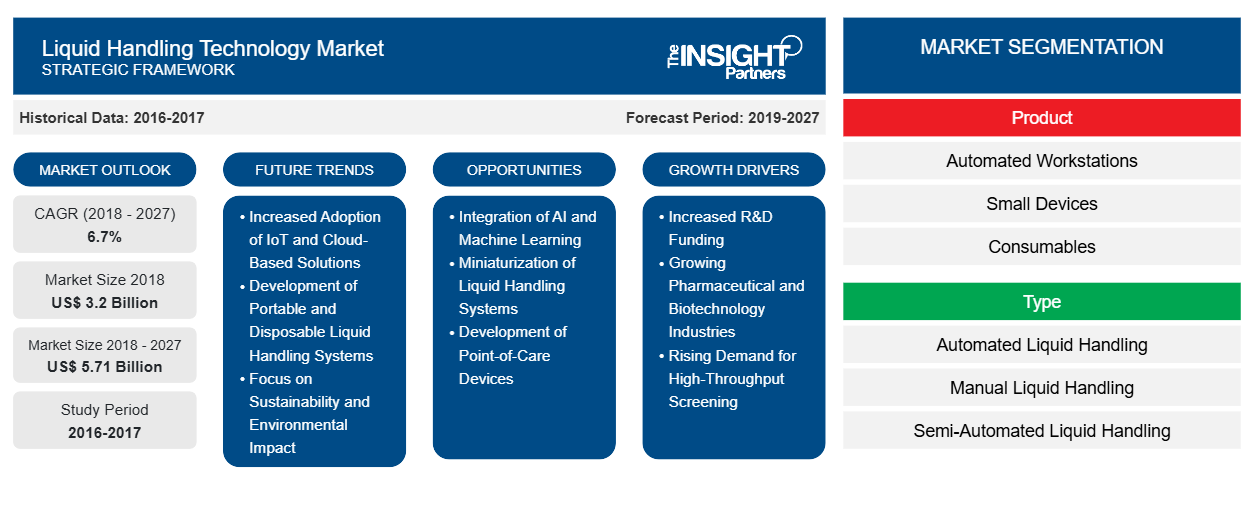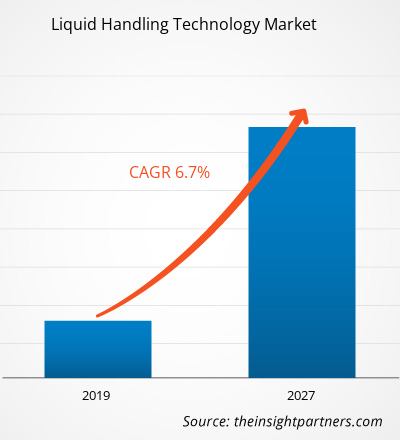2018 年液体处理技术市场价值为 32.0136 亿美元,预计到 2027 年将达到 57.0563 亿美元;预计2019 年至 2027 年的复合年增长率为 6.7%。
液体处理技术用于化学或生化实验室的自动化。对于这些技术,使用各种系统将选定数量的试剂、样品或其他液体分配到指定的容器中。这些系统是集成的软件,允许用户自定义液体处理程序和传输量。全球液体处理技术市场的增长归因于药物发现活动的增加、生物制药行业的增长以及研发费用的增加。然而,熟练专业人员的稀缺是阻碍市场增长的主要因素。
预计全球液体处理技术市场将在疫情后出现大幅增长。由于封锁、旅行禁令和企业停工,COVID-19 影响了各国的经济和行业。COVID-19 危机使许多国家的公共卫生系统不堪重负,凸显了对卫生系统进行可持续投资的强烈需求。随着 COVID-19 疫情的进展,预计医疗保健行业的增长将出现下降。由于对体外诊断产品的需求增加以及全球研发活动的增加,生命科学领域蓬勃发展。然而,由于手术数量减少以及设备采购推迟或延长,医疗技术和成像领域的销售额正在下降。此外,预计医疗保健专业人员的虚拟咨询将成为疫情后主流的医疗服务模式。随着远程医疗改变医疗服务,数字医疗将在未来几年继续蓬勃发展。此外,临床试验中断以及随后的药物上市延迟也有望为未来的完全虚拟试验铺平道路。mRNA等新技术预计将会出现并改变制药行业,未来几年市场也有望见证更多的垂直整合和合资企业。
定制此报告以满足您的需求
您可以免费定制任何报告,包括本报告的部分内容、国家级分析、Excel 数据包,以及为初创企业和大学提供优惠和折扣
- 获取此报告的关键市场趋势。这个免费样品将包括数据分析,从市场趋势到估计和预测。
市场洞察
增加药物研发活动推动全球液体处理技术市场增长
传染病和癌症等慢性病发病率的上升,对高效药物的需求也随之增加。这种需求推动着人们寻求一种能够以更快的速度治疗疾病的高效药物。此外,精准医疗的需求也随之增加。癌症发病率的上升和研究活动的增加,预计将增加世界各地的药物开发活动。
药物开发是一个复杂的过程,需要很长的时间,而且成本高昂,药物成功的可能性也非常低。因此,医疗设备和信息技术的发展和整合推动了自动化设备的创新。这些发展加快了药物发现过程。例如,高通量筛选 (HTS) 是一种用于药物发现的技术,用于筛选具有生物靶标的大量化合物。该技术可以在更短的时间内高效地筛选和分析大量样品。HTS 可以精确分配液体中的大量和微量试剂。
药物发现旨在将液体的运作与其化学结构联系起来,因此可用于识别更多活性化合物。目前,医疗保健领域的研究应用需要更多的药物和生物成分来开发药物。因此,在开发过程中,每批准一种新药,大约需要 5,000-10,000 种液体化学品和生物样品进行实验室筛选。在筛选的化合物中,近 250 种进入临床前测试,5 种开始临床试验。从发现到药物上市的整个过程大约需要 10 到 15 年。
此外,在世界各地,制药、生物制药、生物技术和生命科学研究行业正在呈指数级增长。例如,北美拥有最大的制药和生物制药行业,而亚太地区是制药和生物制药行业增长最快的地区。此外,医疗保健行业的研发活动在世界各地不断增加。因此,这种不断增长的药物发现活动预计将在世界范围内创造对液体处理技术的需求。因此,预计市场在预测期内将大幅增长。
基于产品的洞察
就产品而言,全球液体处理技术市场分为自动化工作站、小型设备和耗材。2018 年,耗材部分占据了最大的市场份额。此外,预计同一部分在预测期内的复合年增长率最高。
基于类型的洞察
根据类型,全球液体处理技术市场分为自动液体处理、手动液体处理和半自动液体处理。半自动液体处理部分在 2018 年占据了最大的市场份额。然而,预计在预测期内,自动液体处理部分的复合年增长率最高。
基于应用的洞察
在应用方面,全球液体处理技术市场细分为药物发现和 ADME-Tox 研究、癌症和基因组研究、生物加工/生物技术。2018 年,药物发现和 ADME-Tox 研究领域占据了最大的市场份额。然而,预计癌症和基因组研究领域在预测期内的复合年增长率最高。
液体处理技术市场区域洞察
Insight Partners 的分析师已详细解释了预测期内影响液体处理技术市场的区域趋势和因素。本节还讨论了北美、欧洲、亚太地区、中东和非洲以及南美和中美洲的液体处理技术市场细分和地理位置。

- 获取液体处理技术市场的区域特定数据
液体处理技术市场报告范围
| 报告属性 | 细节 |
|---|---|
| 2018 年市场规模 | 32亿美元 |
| 2027 年市场规模 | 57.1亿美元 |
| 全球复合年增长率(2018 - 2027) | 6.7% |
| 史料 | 2016-2017 |
| 预测期 | 2019-2027 |
| 涵盖的领域 | 按产品
|
| 覆盖地区和国家 | 北美
|
| 市场领导者和主要公司简介 |
|
市场参与者密度:了解其对商业动态的影响
液体处理技术市场正在快速增长,这得益于终端用户需求的不断增长,而这些需求又源于消费者偏好的不断变化、技术进步以及对产品优势的认识不断提高等因素。随着需求的增加,企业正在扩大其产品范围,进行创新以满足消费者的需求,并利用新兴趋势,从而进一步推动市场增长。
市场参与者密度是指在特定市场或行业内运营的企业或公司的分布情况。它表明相对于给定市场空间的规模或总市场价值,有多少竞争对手(市场参与者)存在于该市场空间中。
在液体处理技术市场运营的主要公司有:
- 安捷伦科技公司
- Aurora Biomed 公司
- AutoGen 公司
- 丹纳赫公司
- Bio-Rad 实验室有限公司
免责声明:上面列出的公司没有按照任何特定顺序排列。

- 了解液体处理技术市场主要参与者概况
基于最终用户的洞察
就最终用户而言,全球液体处理技术市场分为制药和生物技术公司、合同研究组织 (CRO) 以及学术和研究机构。制药和生物技术公司部门在 2018 年占据了最大的市场份额。相比之下,合同研究组织 (CRO) 部门预计在预测期内增长速度最快。
全球液体处理技术市场参与者正在采用产品发布和扩张策略来满足全球不断变化的客户需求,这也使他们能够在全球范围内维护自己的品牌名称。
全球液体处理技术市场 – 按产品分类
- 自动化工作站
- 小型设备
- 移液器
- 分配器
- 滴定管
- 其他的
- 耗材
- 试剂
- 一次性吸头
- 管和板
- 其他的
全球液体处理技术市场 – 按类型
- 自动化液体处理
- 手动液体处理
- 半自动化液体处理
全球液体处理技术市场 – 按应用划分
- 药物研发和 ADME-Tox 研究
- 癌症和基因组研究
- 生物加工/生物技术
全球液体处理技术市场 – 按最终用户划分
- 制药和生物技术公司
- 合同研究组织(CRO)
- 学术及研究机构
全球液体处理技术市场 – 按地区划分
北美
- 我们
- 加拿大
- 墨西哥
欧洲
- 法国
- 德国
- 意大利
- 英国
- 西班牙
- 欧洲其他地区
亚太地区 (APAC)
- 中国
- 印度
- 韩国
- 日本
- 澳大利亚
- 亚太地区其他地区
中东和非洲 (MEA)
- 南非
- 沙特阿拉伯
- 阿联酋
- MEA 其他地区
南美洲和中美洲(SCAM)
- 巴西
- 阿根廷
- 其余的骗局
公司简介
- 安捷伦科技公司
- Aurora Biomed 公司
- Autogen 公司
- 丹纳赫(贝克曼库尔特公司)
- Bio-Rad 实验室有限公司
- 耶拿分析仪器公司
- 康宁公司
- 艾本德
- Formulatrix 公司
- 吉尔森公司
- 历史分析(2 年)、基准年、预测(7 年)及复合年增长率
- PEST 和 SWOT 分析
- 市场规模价值/数量 - 全球、区域、国家
- 行业和竞争格局
- Excel 数据集


- Nuclear Waste Management System Market
- Integrated Platform Management System Market
- Aesthetic Medical Devices Market
- Sterilization Services Market
- Authentication and Brand Protection Market
- Drain Cleaning Equipment Market
- Flexible Garden Hoses Market
- Machine Condition Monitoring Market
- Environmental Consulting Service Market
- Excimer & Femtosecond Ophthalmic Lasers Market

Report Coverage
Revenue forecast, Company Analysis, Industry landscape, Growth factors, and Trends

Segment Covered
This text is related
to segments covered.

Regional Scope
North America, Europe, Asia Pacific, Middle East & Africa, South & Central America

Country Scope
This text is related
to country scope.
Trends and growth analysis reports related to Life Sciences : READ MORE..
The List of Companies
- Agilent Technologies, Inc.
- Aurora Biomed Inc.
- AutoGen, Inc.
- Danaher Corporation
- Bio-Rad Laboratories, Inc.
- Analytik Jena AG (Endress+Hauser Management AG)
- Corning Incorporated
- Eppendorf
- Formulatrix, Inc.
- Gilson Incorporated
The Insight Partners performs research in 4 major stages: Data Collection & Secondary Research, Primary Research, Data Analysis and Data Triangulation & Final Review.
- Data Collection and Secondary Research:
As a market research and consulting firm operating from a decade, we have published and advised several client across the globe. First step for any study will start with an assessment of currently available data and insights from existing reports. Further, historical and current market information is collected from Investor Presentations, Annual Reports, SEC Filings, etc., and other information related to company’s performance and market positioning are gathered from Paid Databases (Factiva, Hoovers, and Reuters) and various other publications available in public domain.
Several associations trade associates, technical forums, institutes, societies and organization are accessed to gain technical as well as market related insights through their publications such as research papers, blogs and press releases related to the studies are referred to get cues about the market. Further, white papers, journals, magazines, and other news articles published in last 3 years are scrutinized and analyzed to understand the current market trends.
- Primary Research:
The primarily interview analysis comprise of data obtained from industry participants interview and answers to survey questions gathered by in-house primary team.
For primary research, interviews are conducted with industry experts/CEOs/Marketing Managers/VPs/Subject Matter Experts from both demand and supply side to get a 360-degree view of the market. The primary team conducts several interviews based on the complexity of the markets to understand the various market trends and dynamics which makes research more credible and precise.
A typical research interview fulfils the following functions:
- Provides first-hand information on the market size, market trends, growth trends, competitive landscape, and outlook
- Validates and strengthens in-house secondary research findings
- Develops the analysis team’s expertise and market understanding
Primary research involves email interactions and telephone interviews for each market, category, segment, and sub-segment across geographies. The participants who typically take part in such a process include, but are not limited to:
- Industry participants: VPs, business development managers, market intelligence managers and national sales managers
- Outside experts: Valuation experts, research analysts and key opinion leaders specializing in the electronics and semiconductor industry.
Below is the breakup of our primary respondents by company, designation, and region:

Once we receive the confirmation from primary research sources or primary respondents, we finalize the base year market estimation and forecast the data as per the macroeconomic and microeconomic factors assessed during data collection.
- Data Analysis:
Once data is validated through both secondary as well as primary respondents, we finalize the market estimations by hypothesis formulation and factor analysis at regional and country level.
- Macro-Economic Factor Analysis:
We analyse macroeconomic indicators such the gross domestic product (GDP), increase in the demand for goods and services across industries, technological advancement, regional economic growth, governmental policies, the influence of COVID-19, PEST analysis, and other aspects. This analysis aids in setting benchmarks for various nations/regions and approximating market splits. Additionally, the general trend of the aforementioned components aid in determining the market's development possibilities.
- Country Level Data:
Various factors that are especially aligned to the country are taken into account to determine the market size for a certain area and country, including the presence of vendors, such as headquarters and offices, the country's GDP, demand patterns, and industry growth. To comprehend the market dynamics for the nation, a number of growth variables, inhibitors, application areas, and current market trends are researched. The aforementioned elements aid in determining the country's overall market's growth potential.
- Company Profile:
The “Table of Contents” is formulated by listing and analyzing more than 25 - 30 companies operating in the market ecosystem across geographies. However, we profile only 10 companies as a standard practice in our syndicate reports. These 10 companies comprise leading, emerging, and regional players. Nonetheless, our analysis is not restricted to the 10 listed companies, we also analyze other companies present in the market to develop a holistic view and understand the prevailing trends. The “Company Profiles” section in the report covers key facts, business description, products & services, financial information, SWOT analysis, and key developments. The financial information presented is extracted from the annual reports and official documents of the publicly listed companies. Upon collecting the information for the sections of respective companies, we verify them via various primary sources and then compile the data in respective company profiles. The company level information helps us in deriving the base number as well as in forecasting the market size.
- Developing Base Number:
Aggregation of sales statistics (2020-2022) and macro-economic factor, and other secondary and primary research insights are utilized to arrive at base number and related market shares for 2022. The data gaps are identified in this step and relevant market data is analyzed, collected from paid primary interviews or databases. On finalizing the base year market size, forecasts are developed on the basis of macro-economic, industry and market growth factors and company level analysis.
- Data Triangulation and Final Review:
The market findings and base year market size calculations are validated from supply as well as demand side. Demand side validations are based on macro-economic factor analysis and benchmarks for respective regions and countries. In case of supply side validations, revenues of major companies are estimated (in case not available) based on industry benchmark, approximate number of employees, product portfolio, and primary interviews revenues are gathered. Further revenue from target product/service segment is assessed to avoid overshooting of market statistics. In case of heavy deviations between supply and demand side values, all thes steps are repeated to achieve synchronization.
We follow an iterative model, wherein we share our research findings with Subject Matter Experts (SME’s) and Key Opinion Leaders (KOLs) until consensus view of the market is not formulated – this model negates any drastic deviation in the opinions of experts. Only validated and universally acceptable research findings are quoted in our reports.
We have important check points that we use to validate our research findings – which we call – data triangulation, where we validate the information, we generate from secondary sources with primary interviews and then we re-validate with our internal data bases and Subject matter experts. This comprehensive model enables us to deliver high quality, reliable data in shortest possible time.


 获取此报告的免费样本
获取此报告的免费样本